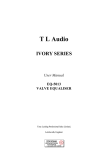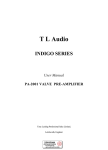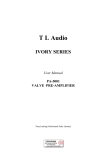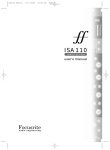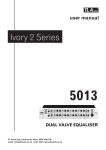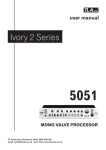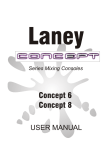Download User Manual
Transcript
T L Audio CRIMSON SERIES User Manual EQ-3012 PARAMETRIC EQUALISER Tony Larking Professional Sales Limited, Letchworth, England. Tel: 01462 490600. International +44 1462 490600. Fax: 01462 490700. International +44 1462 490700. INTRODUCTION The T L Audio Crimson Series utilises low noise solid state circuitry to produce audio processing units offering very high quality signal paths with comprehensive control facilities. The Crimson Series are straight-forward to operate, and offer excellent value for money. The EQ-3012 is a four band, fully parametric equaliser. The four bands may be configured as two bands on each of the equaliser’s two channels, or cascaded to form a single channel, four band equaliser. Bands 1 and 2 are normally configured in channel A, and bands 3 and 4 in channel B, but frequency range multiplier switches on bands 2 and 3 provide a flexible four band mode with detailed coverage of the entire audio bandwidth. The block diagram of the equaliser is shown in fig.1. It has three input sources - a balanced line level input via an XLR connector, an unbalanced line level input via a jack socket, and an instrument input also on an unbalanced jack socket but located on the front panel where it provides a convenient means of patching a guitar or keyboard directly into the equaliser. All three inputs may be used simultaneously. The gain of the input stages is controlled by a centre-detented control, calibrated for 0dB nominal gain from the line input sources at the centre and providing +/-20dB of variation. The instrument input has a sensitivity switch associated with it, to match the gain to a low level pickup (e.g. a passive guitar or microphone) or a higher output source such as a keyboard or active guitar, followed by the 40dB variation of the input gain control Following the channel A input stages are two parametric equaliser stages. Band 1 offers fully variable cut/boost, centre frequency and Q (bandwidth) control. Band 2 is similar, but also includes a divide by 10 frequency range switch. A variable intensity peak LED monitors the output of the equaliser stages, providing an indication of the amount of drive and headroom available. The signal chain is completed by an EQ-in switch plus balanced and unbalanced output driver stages. Channel B is also configured with two bands of fully parametric equalisation - band 3 including a frequency range multiplier switch. In 4 band mono mode, the input stages of channel B are replaced with the output of channel A’s equalisation, cascading all four bands onto the same audio path. In this mode, the signal input is via channel A and the output is via channel B. The output from channel A remains operative, but with just the first two bands of equalisation effective. Please read this manual fully before installing or operating the Equaliser. PRECAUTIONS The T L Audio EQ-3012 Parametric Equaliser requires very little installation, but like all electrical equipment, care must be taken to ensure reliable, safe operation. The following points should always be observed: - All mains wiring should be installed and checked by a qualified electrician, - Ensure the correct operating voltage is selected on the rear panel before connecting to the mains supply, - Never operate the unit with any cover removed, - Do not expose to rain or moisture, as this may present an electric shock hazard, - Replace the fuse with the correct type and rating only. Warning: This equipment must be earthed. INSTALLATION AC Mains Supply. The unit is fitted with an internationally approved 3 pin IEC connector. A mating socket with power cord is provided with the unit, wired as follows: Brown: Live. Blue: Neutral. Green/Yellow: Earth (Ground). All mains wiring should be performed by a qualified electrician with all power switched off, and the earth connection must be used. Before connecting the unit to the supply, check that the voltage selector switch on the rear panel is correctly set. The unit may be set for 115V (accepting voltages in the range 110V to 120V, 60Hz AC), or to 230V (for voltages in the range 220V to 240V, 50Hz AC). Adjustment to the operating voltage should be made by sliding the selector switch left or right with a small screwdriver until the desired voltage is displayed. The mains fuse required is 20mm anti-surge, 1AT rated at 250V. If it ever necessary to replace the fuse, only the same type and rating must be used. The power consumption of the equipment is 30VA. Warning: attempted operation on the wrong voltage setting, or with an incorrect fuse, will invalidate the warranty. Audio Operating Level. The equaliser is equipped with inputs and outputs suitable for connection to a wide variety of other audio equipment. Generally, the balanced XLR connections will be required for interfacing to other professional equipment, where the operating level (line-up level or nominal level) will be +4dBu, or about 1.2V rms. The unbalanced jack connectors are generally intended for interfacing to semi-professional equipment and have an operating level of -10dBu, or about 225mV rms. The equaliser may be used to change between operating levels, for example by connecting the unbalanced output of a semi-pro mixing console to the equaliser’s unbalanced input, and taking the balanced output of the equaliser to the balanced input of a tape machine at +4dBu. All inputs and outputs of the equaliser may be used simultaneously if required. Balanced interconnection is always preferable to obtain the best headroom and noise rejection, but can only be used if the other equipment in the chain, e.g. the mixing console, also has provision for balanced connections. Audio Inputs. Each channel has a female, 3 pin XLR connector, suitable for balanced or unbalanced line sources at a nominal level of +4dBu. The mating connector should be appropriately wired as follows for balanced or unbalanced operation: Balanced inputs: - Pin 1 = Ground (screen). - Pin 2 = Signal Phase (also known as “+” or “hot”). - Pin 3 = Signal Non-Phase (“-” or “cold”). Unbalanced inputs: - Pin 1 = Ground (screen) - Pin 2 = Signal Phase (“+” or “hot”). - Pin 3 = Signal Ground When using unbalanced signals, the signal ground may be obtained by linking pins 1 and 3 in the mating XLR connector. If this connection is not made, a loss in level may result. Unbalanced Line Inputs. An unbalanced line level input at a nominal level of -10dBu is also provided for each channel, on a 0.25” mono jack socket. The mating plugs should be wired as follows: - Tip = Signal Phase (“+” or “hot”). - Screen = Ground. Auxiliary Inputs. A 2 pin (mono) jack plug is required, which should be wired as follows: - Tip = Signal Phase (“+” or “hot”). - Screen = Ground. The auxiliary input is suitable for direct connection of instruments including guitars and keyboards. Good quality screened cable should be used, particularly for microphone or low level sources, to prevent hum or noise pickup. Balanced Outputs. The output is via a balanced, 3 pin male XLR connector. The mating connector should be wired as follows: - Pin 1 = Ground (screen), - Pin 2 = Signal Phase (“+” or “hot”), - Pin 3 = Signal Non-Phase (“-” or “cold”). Unbalanced Outputs. An unbalanced line output is provided for each channel, on a 0.25” mono jack socket. - Tip = Signal Phase (“+” or “hot”). - Screen = Ground. Mounting. The equaliser may be free standing, or mounted in a standard 19” rack. Do not locate the unit where it will be subject to external heating, for example in the hot air flow from a power amplifier, or on a radiator. Rear Panel. The rear panel connectors are identified in fig.3. Make sure that all settings, mains and audio connections have been made as described above before attempting to operate the equipment. OPERATION. Front Panel. The front panel controls are identified in fig.2. Input Gain. The input gain of the equaliser may be varied over a range of +/-20dB, which combined with the different sensitivity inputs, provides adequate and precise control of signal level. Generally, enough gain should be applied to make the peak LED glow on the louder sections of music, without causing the LED to illuminate brightly for an extended time. This will provide the optimum signal to noise ratio whilst allowing plenty of headroom for boost in the equaliser. The front panel auxiliary input sockets may be switched between high level signals (“LO GAIN”, suitable for active guitars and keyboards) and low level signals (“HI GAIN”, suitable for microphones, pick ups or passive guitars), and are also controlled by the input gain control. Peak LED. The peak LED indicates the output level from the equaliser stages. The LED will start to glow at a level of +6dBu referred to the balanced output, and be fully illuminated at +16dBu, where there is still 10dB of output headroom remaining. Equalisation. Before switching the EQ into circuit, it is advisable to set the cut/boost controls to their centre, or flat, position. The EQ is brought into circuit with the overall “EQ-IN” push switch, signalled by a green LED. All four bands of equalisation are equipped with fully variable cut and boost controls offering +/-15dB of range, swept frequency and variable Q, making them much more versatile than equalisers equipped with non-variable frequency or Q settings. (The “Q” of the filter is a measure of the shape of the frequency response curve, and is closely related to the bandwidth, or range of frequencies, controlled by the filter). High Q settings (about 5 at the maximum setting on the 3012) result in sharp, narrow bandwidths generally used for audio correction or effects. Intermediate settings, say 1 to 3, are generally used to enhance or reduce a broader range of frequencies, typically to make an instrument or vocal “stand out”, or recede, into the mix. Finally, low Q values (down to about 0.5 on the 3012) provide more gentle contouring, or “sweetening” of the response. Band 1. This band is always operative on channel A and covers the low-to-mid frequency range of 30Hz to 1K2Hz. The amount of cut and boost available is up to +/-15dB, and the Q is variable from 0.5 (a broad response) to 5 (a narrow peak). Band 2. Also operative on channel A, this band normally covers the mid-to-upper frequency range of 1KHz to 18KHz. However, the divide by 10 range switch moves this band to 100Hz to 1K8Hz. Band 3. This band is normally operative on channel B, covering the low-to-mid frequency range of 30Hz to 1K2Hz. However, the multiply by 10 range switch moves this band to 300Hz to 12KHz. Band 4. This band is also normally operative on channel B, covering the mid-to-upper frequency range of 1KHz to 18KHz. Bypass. The Equaliser In switch allows the processing to be bypassed for comparison of the equalised and original, unprocessed signal. 4 Band Mono Mode. This mode allows all four bands to be placed in the same audio path, for very comprehensive equalisation tasks. In dual channel or stereo mode, the frequency ranges of band 2 would normally be the same as band 4, and band 3 would normally follow band 1. However, in 4 band mode, the range select switches allow the bands to be split into traditional LF, LM, HM and HF areas. When using the 4 band mode, the input signal should be connected to channel A, and the output taken from channel B. The outputs from channel A will continue to operate, but with only bands 1 and 2 of the equaliser effective. The inputs and input gain control on channel B are disabled in mono mode. SPECIFICATIONS Balanced Line Input: Electronically balanced, unbalanced compatible, with input impedance greater than 5Kohm. Gain range -20dB to +20dB. Nominal input level +4dBu. Maximum input level +26dBu. 3 pin female XLR connector. Unbalanced Input: Input impedance greater than 5Kohm. Gain range -20dB to +20dB. Nominal input level -10dBu. Maximum input level +12dBu. 2 pole 0.25” jack socket. Auxiliary Input: Switchable for high or low gain, plus 40dB gain variation. Maximum input level +18dBu. 2 pole 0.25” jack socket. Band 1: Cut and Boost: +/-15dB. Frequency Range: 30Hz to 1K2Hz. Q variable 0.5 to 5. Band 2: Cut and Boost: +/-15dB. Frequency Range: 1KHz to 18KHz, 100Hz to 1K8Hz with divide by 10 switch. Q variable 0.5 to 5. Band 3: Cut and Boost: +/-15dB. Frequency Range: 30Hz to 1K2Hz, 300Hz to 12KHz with multiply by 10 switch. Q variable 0.5 to 5. Band 4: Cut and Boost: +/-15dB. Frequency Range: 1KHz to 18KHz. Q variable 0.5 to 5. Balanced Outputs: Electronically balanced, unbalanced compatible. Nominal level +4dBu. Output impedance 47 ohms. Maximum level +26dBu. 3 pin male XLR connector. Unbalanced Outputs: Output impedance 47 ohms. Nominal level -10dBu. Maximum level +18dBu into 10Kohms. 2 pole 0.25” jack socket. Frequency Response: 10Hz to 40KHz, +0, -1dB. Noise: -76dBu (22Hz - 22KHz). Dynamic Range: 102dB. Power Requirements: Rear panel selectable for 220-240V 50Hz or 110-120V 60Hz operation. Rear panel fuse 20mm, 1AT, 250V. Power consumption 30VA typical. Detachable 3 pin IEC connector, mating connector and cable supplied. Front panel On/Off switch with green LED. Dimensions: 19” rack mounting, 1U high. 483mm wide x 44mm high x 250mm deep. Weight: 4Kg. The above specifications are subject to change without notice. SERVICE Should the equaliser require service, it must be taken or posted to an authorised dealer. Please retain the original packing for possible future use, and ensure the unit is suitably protected during transit. The manufacturer cannot accept responsibility for damage caused during transportation. The equaliser is supported by a limited warranty for a period of one year from the date of purchase. During this period, any faults due to defective materials or workmanship will be repaired free of charge. The warranty excludes damage caused by deliberate or accidental misuse, operation on the incorrect mains voltage, or without the correct type and value of fuse fitted. It is the user’s responsibility to ensure fitness for purpose in any particular application. The warranty is limited to the original purchase price of the equipment, and excludes any consequential damage or loss. Please retain proof of purchase, and record the following details: Serial Number............................. Date purchased........................... Dealer.........................................













